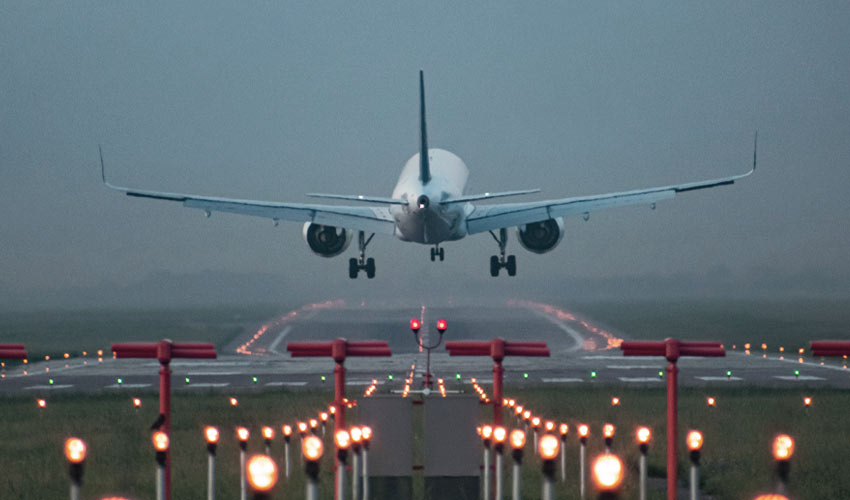Despite the ongoing impacts from the global pandemic, the Ukraine War, supply chain disruptions, labor shortages and other troubled economies in many regions, the aviation industry is continuing to rebound. Airlines and airports alike are making strides with some organizations and regions faring better than others. The industry, as a whole, has also solidified its commitment to attaining net zero emissions by 2050.
COVID-19 Impacts Persist but Aviation Forges Ahead
Based on an Airports Council International (ACI) World quarterly assessment providing an assessment of how the COVID-19 pandemic has affected airports and their overall recovery, there are still a lot of challenges to overcome. With a world already grappling with economic problems and declining consumer confidence, along with the uncertainties associated with the Ukraine War, and supply chain bottlenecks, recovery for aviation is still a long climb up a steep mountain. However, with many nations having eliminated COVID-related travel restrictions, airport passenger traffic is getting stronger but remains uneven across different regions. Whereas North America and Europe are starting to regain momentum, Asia-Pacific is still lagging behind as evidenced by the ACI’s findings analyzing regional performance in the first half (H1) of 2022 versus the same period in 2019. It found:
- The Asia-Pacific markets of Japan at 39% of H1 2019 levels, and Thailand at 31% and China at 28% below its pre-pandemic levels.
- The United States is at 87%, Spain at 82%, Brazil at 80% and India at 75% of 2019 levels.
- Columbia, Mexico and Nigeria are experiencing an increase in demand which exceeds their 2019 levels.
Other key data to come from the ACI assessment include:
- COVID-19 reduced air traffic by 5.2 billion passengers representing an attributed loss of 49.5% when compared to 2019 results or a loss of 4.5 billion passengers.
- During Q1 and Q2 of 2022, global passenger volume was 1.3 billion and 17 billion respectively, or 62% and 75.2% respectively of their 2019 levels.
- The Latin America-Caribbean region had the strongest performance in H1 2022 over other regions with declines of 23.7% and 24.9% in Q1 and Q2 2022 compared with 2019’s baseline of 84.6% and 94.9% of 2019 levels.
- The Middle East continued its recovery in Q1 and Q2 2022 losing 39.5% and 28% of its passenger traffic compared to the projected bases of 72% and 84.2% of 2019 levels.
- Africa also experienced gains with declines of 44.4% and 36.1% for Q1 and Q2 2022 respectively, compared to the projected baseline of 70.2% and 80.2% of 2019 levels.
Currently, international travel is projected to recover by 2024.
Under the United Nations Civil Aviation Body, 184 Nations Agree to a Net Zero Emissions Goal by 2050
The United Nations (UN) body of civil aviation recently agreed to work to achieve a goal of net zero CO2 emissions by 2050. In doing so, representatives of 184 nations will be having their emissions handled by the International Civil Aviation Organisation (ICAO), a UN entity. The agreement by the 184 nations to adopt this “aspirational” goal is occurring one year after most of the global aviation industry represented by the International Air Transport Association (IATA) had committed to achieving net zero emissions by 2050.
There will be cost impacts to achieving this goal. According to the NGO Transport & Environmental (T&E), It is estimated that a flight from Europe to the United States would incur an additional £ 1.70 to a ticket price by 2030 to offset certificate costs.
Noteworthy is a projection by the ICAO that actual international aviation emissions could rise higher based on the current pace of technological and policy development. The ICAO is projecting a potential increase to 954 mega tons (Mt) of CO2 in 2050, almost double the 500 Mt. of 2019.


Airlines and Punctuality
Despite the severe labor shortages and ongoing COVID-19 impacts, some airlines did well when it came to on-time performance – some even managed to do so in the face of other mounting challenges. Here’s how some airlines performed based on data collected by Cirium’s aviation analytics experts and published in their August 2022 report.
The Brazilian carrier, Azul, topped in punctuality with an estimated on-time performance (OTP) rate of 89.31%. Close behind with an 87.47% rate was SA Avianca, and in third place was LATAM Airlines (LA) with 85.56% of flights arriving on time. Rounding out the top ten were: ANA (85.29%), JAL (84.65%), Delta Airlines (83.69%), Aeromexico (81.51%), United Airlines (79,89%), Qatar Airways (77.86%) and American Airlines (75.78%).
Delta’s appearance on the list is especially significant since the airline received widespread coverage of its overbooked flights, long lines and cancellations. The airline launched some new routes to exciting destinations including Tahiti, French Polynesia; Cape Town, South Africa; and Tel Aviv, Israel, and is relaunching flights to South Korea.
IATA World Air Transport Statistics (WATS) Recognizes Top 25 Air Cargo Airlines
While continuing to face labor shortages, limited capacity, and pandemic-related congestion, the IATA World Air Transport Statistics (WATS) data demonstrates that the top 25 air cargo airlines performed well. For example, scheduled cargo tonne km (CTK) terms increased by 18.7% year on year in 2021. That is a major improvement over 2020’s 10.6% decline.
The top 25 air cargo carriers’ performance was in line with the overall market with these airlines experiencing cargo volume increases by 18.8% year on year; a function of the opening up of global economies following COVID-19’s peak period. Airfreight also benefitted from high prices and disruptions in ocean shipping which found shippers and freight forwarders turning to airfreight as an alternative. IATA WATS also data also included the statistic that air cargo generated $204 billion in revenues in 2021, far surpassing 2020’s $135.8 million.
Regional Performance
Apart from air cargo carriers in Latin America, most other regions saw their cargo airlines experience increase demand in 2021. Here’s how some of the regions performed:
- North America experienced growth in capacity in 2021; the only region where this occurred.
- The Middle East saw carriers report a 10.5% increase in CTKs.
- Europe saw carriers record a 3.7% increase in CTKs.
- Asia-Pacific experienced a 0.2% increase in CTKs.
- Africa saw growth of 10.2% buoyed by a flow of goods and investments from China.
- Latin America saw a contraction in demand of 15.4% due to restructuring processes in 2021.
FedEx – Still #1
As for which air cargo airlines performed best, FedEx held on to its top berth in 2021, seeing its cargo volumes increase by 5.1% year on year to 20.7 billion CTK. Its position can, in part, be attributed to e-commerce and COVID vaccines and personal protection equipment shipment demands. Additionally, benefitting many cargo carriers was the increase in international export volume stemming from high demand for international priority shipments. Other leaders in 2021 were Qatar Airways, United Parcel Service, Emirates, and Korean Air.





0 comments on “Aviation Wrap-Up October 2022”